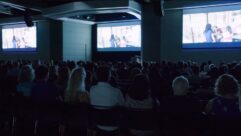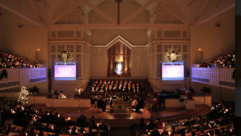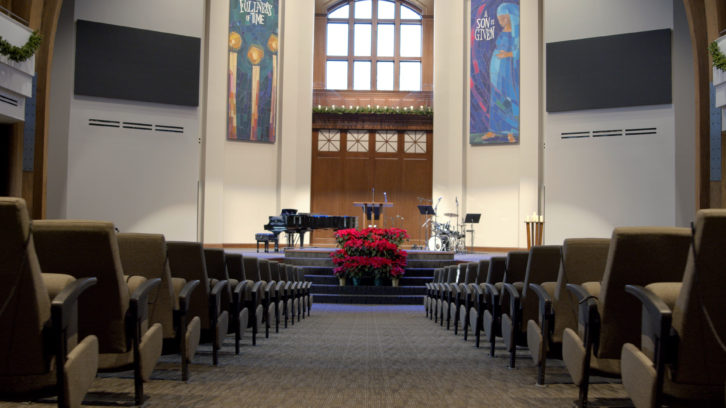
In Brentwood, Tennessee, near Nashville, Grace Community Church had outgrown its sanctuary and decided to build a big new one. They called in Integrated Production Solutions (IPS) to handle audio, video, lighting and power from the ground up. Integration Systems Designer Bryan Levy has the whole story.
SVC: Bryan good to have you with us on the SVC Podcast from Integrated Production Solutions (IPS) in Franklin, Tennessee. I have the equipment list–its pages and pages of AV gear. I get tired just looking at it.
Bryan Levy: [Laughs] Yeah, there was quite a bit that went into that structure; especially since it was an exposed tongue-in-groove ceiling with really high arches. So yeah, a lot of stuff packed into a neat space.
Tell us about IPS, Integrated Production Solutions.
IPS does installations as well as rentals, so we actually have two divisions of our company. I’m on the integration team side as a system designer and project manager; that is what I do exclusively. But it’s been awesome to have a rental side as well so when one is slow the other one’s keeping up and vice versa, especially during Covid and post-Covid. Our bread and butter is houses of worship. We also do commercial installations. I’ve got something coming out of a government complex here at the beginning of 2022. So if you can dream it up we can probably put it in there.
This was a huge investment for Grace Community Church. What sort of help did they need?
The church was meeting in an existing building and they added a new sanctuary that was almost five times the size of the existing one. They were doing two and three services a Sunday just to get all their congregants in the door. So they built a brand new sanctuary that’s attached to the existing building. Stylistically it’s a laminated veneer building, so a lot of wood, a lot of hard surfaces. From the floor to the ceiling is like 63 feet so they actually had to leave windows out just to get equipment in until the very end. It’s kind of a mixed congregation so they blend a lot of traditional music with contemporary music. With it being a brand new space, and knowing that the room was probably going to be acoustically challenging, we planned production equipment that would deal with that, so everyone is getting great sound and a great way of viewing the stage with all its intricacies no matter what.
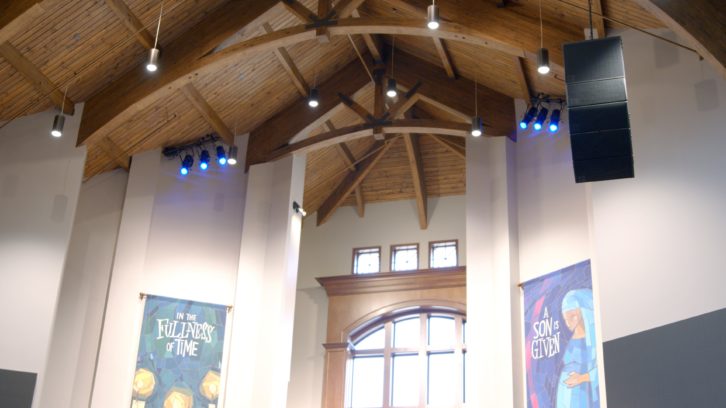 You don’t always see the AV contractor install everything right down to the power for the building but that was the opportunity here. You went with a LynTec system.
You don’t always see the AV contractor install everything right down to the power for the building but that was the opportunity here. You went with a LynTec system.
We use LynTec a lot on projects just because the product is rock solid and it gets rid of the guesswork and the mistakes that could happen during powering on/powering off sequencing, or especially if not all the power is localized in one location, which was the case here. They had an RPC48 in a second floor electrical room, an RPCR8 with double pole relay inserts in a downstairs rear of the house electrical room, and even XRS20s in their front-of-house that were all networked together to have just a simple on and off topology where no one had to remember ‘oh, amps before console’ or vice versa. The lighting is all LED because they don’t have the ability to get to it easily. So just being able to turn off everything properly and turn it on only when needed extends the lifespan of a lot of this equipment that’s relatively inaccessible.
What did you install for their lighting? There was a lot of cabling to do since this was a brand new facility and other contractors to work with.
[Laughs] Yeah, we had a new facility so all new cable. We were working with the general contractor and the electrical contractor even in the planning stages before the slab was poured because it’s all vaulted ceiling where you can’t have exposed pipe; they really wanted the aesthetics of the facility to be the main focal point. The production staff, and worship leaders, and of course the pastor, wanted the building to have this beauty, they didn’t want to adulterate. They wanted to ensure that everything was of great quality and they weren’t going to have issues down the road. So everything’s LED for that long-term lifespan. It’s the Ovation series from Chauvet, their warm white 260s with various lenses depending on what battens they were on. Up closer to the stage they had some big walls of banners that were really important to them so we used the KL 8 fresnels from Elation as well as some of Chauvet’s Ovation Series for key lighting from the back. And then Ayrton Perseo. We had specified an Ayrton Ghibli, but at the time with all the shipping shortages a Ghibli wasn’t going to be available in time. So we were able to swap that out for basically its waterproof cousin, the Perseo, to give them the functionality of being able to do things off the cuff.
And they have an all-volunteer tech crew there?
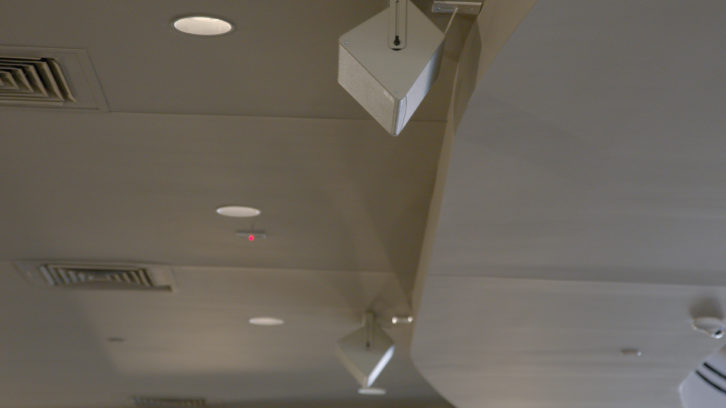 Yes. Everyone is a volunteer. I guess the executive pastor, who is the facilities guy, is on staff, but everyone else is a volunteer. So it can be a different person mixing or doing lighting or running the video stream. They also have a separate audio console for doing a mix down just for the online streams. They have quite a few volunteers that are present for each service.
Yes. Everyone is a volunteer. I guess the executive pastor, who is the facilities guy, is on staff, but everyone else is a volunteer. So it can be a different person mixing or doing lighting or running the video stream. They also have a separate audio console for doing a mix down just for the online streams. They have quite a few volunteers that are present for each service.
So not only does it have to be reliable but everything you installed has to be easy to operate as well.
Yes, sir.
You added IP-based control. How do the Luxul Ethernet switches work for that?
Along with d&b and LynTec being some of our favorite industry partners, we use Luxul a lot. They’re designed for the AV world so their Layer Two and Layer Three management style allows us to create trunks and VLANs. We can get all of the infrastructure, whether it’s PoE cameras, the network control for LynTec, obviously Dante, integrated. We had quite a few switches there, one in front of house, back of house, another back of room rack, just to get everything that’s AV talking to each other. The Luxul switches do a fantastic job of being easily deployable, super reliable, and honestly just a great function/cost equation.
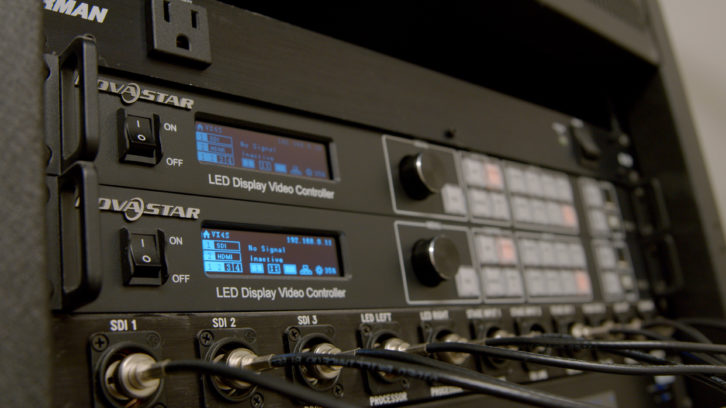 How is the lighting controlled?
How is the lighting controlled?
All the AV control is in the balcony, which for audio isn’t always ideal. But we were able to compensate for that with the GSUBs on top of the A-series d&bs that were flown in the house. We still have great low end on the balcony side as well as the subs that are on the ground level with all the underbalcony fills. It’s a fantastically designed and deployed system there, especially for a challenging room with a lot of overhangs and hard surfaces. We were really able to dial that in and work with our d&b personnel to find the best option with the best coverage. Everything is at front of house. Lighting is going via ARCNET from Jands Vista M1 and a touchscreen all-in-one PC. So it boots right into the Jands platform instead of going through Windows and opening an application. We’ve got it in Console mode and then it’s distributed throughout the facility, just because lighting in the DMX is coming from conduit from one side of the building and because the tongue-in-groove doesn’t allow you to make enough bends to get back to a single room.
You did the sound system as well. You went with d&b audiotechnik.
That’s correct, yes, for the clarity of the system and the ease of deployment. And being able to just call d&b up directly and say ‘hey, what about this? What would you consider?’ They’re a wealth of knowledge with a fantastic inventory of really great versatile speakers. We are very happy with our d&b partnership and we will always try to plug them where we can. This system has two column units, a left and right stack, with a sub on top with four As beneath, and 10Ss on the sides for really awkward corner fill that we had to do for the very edge under the overbalcony. And then there are ten 8Ss underneath the balcony lip because that lip came just low enough where we would lose the bottom of the PA. Because like I said, everything there was based on making sure the aesthetics and the beautification of the facility was not overshadowed by technology. So we did have to tuck that PA up a bit. We had custom brackets made in Germany for us to fly this PA without all the intrusive touring rigging. So it’s a very sleek-looking PA in that facility for sure.
How do you mic the pastor and the choir and handle all of the live music?
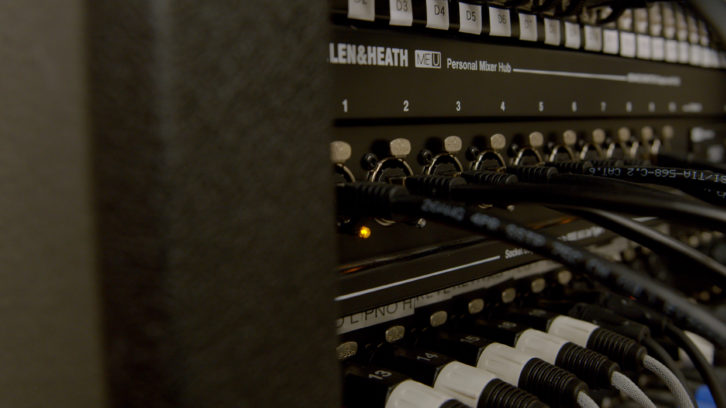 The pastor is on a DPA 4066. We love DPA for those mics. Just great reception. A lot of gain for feedback. And we have had zero problems with DPA, so that’s another one of those brands that when you want something quality they’re just rock solid, DPA has done a great job for us. The choir is not every Sunday. So they have some KSM32s for that whenever they are used. And the rest of the live musicians use a mix of Shure and Earthworks microphones for their piano just to get that really warm, organic sound. That’s all going through an Allen & Heath Advantis system with a GX48, a DX168, and I have a small box for drums. And then the musicians are all using ME-1s to mix their own ears on the stage as well.
The pastor is on a DPA 4066. We love DPA for those mics. Just great reception. A lot of gain for feedback. And we have had zero problems with DPA, so that’s another one of those brands that when you want something quality they’re just rock solid, DPA has done a great job for us. The choir is not every Sunday. So they have some KSM32s for that whenever they are used. And the rest of the live musicians use a mix of Shure and Earthworks microphones for their piano just to get that really warm, organic sound. That’s all going through an Allen & Heath Advantis system with a GX48, a DX168, and I have a small box for drums. And then the musicians are all using ME-1s to mix their own ears on the stage as well.
That really frees-up the musicians and gives them a lot more confidence.
Yeah. And the best part is because it’s all through the same Allen & Heath system, the communication between the console to everything just works beautifully–it transfers the names from the desk to the ME-1s as well so you’re not having to put tape on them. They have a digital display and it gives them 40 channels to choose from. You’re not just limited to the first 16 or the first 32. They can pick and choose any of the 40 to be in their 16 channels of grouping, so if the drummer needs more drum pieces individually he can. If the guitarist only wants one channel for drums they can. So it’s super versatile and super musician-friendly just for getting the right balance you need for yourself to perform well.
What about the video system?
They had to get the streaming operation going. So in the original drawing that happened pre-Covid, they weren’t doing a lot of streaming. When they got in the new facility they said ‘oh, we’re just going to put up some really big TVs’. We didn’t think that was going to be proportional to the space. So we ended up going with squareV LED and that’s really one of our big LED partners as well. They just so happen to be down a few suites from us here in Franklin, so we know we’re always going to get great service and if we ever have a question I can just literally walk down the street, which is fantastic.
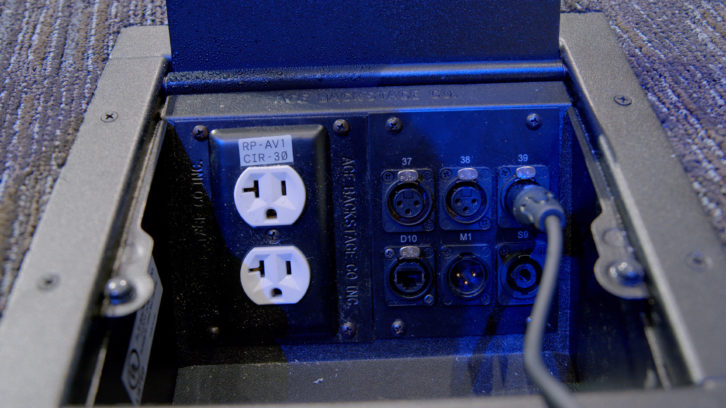 Where are those displays located?
Where are those displays located?
On the house left and house right side of the stage, just kind of an angled wall there–where a traditional projection would be. But that room has got immense amounts of outdoor lighting coming in through the very large windows they have on three of the four sides. So projection wasn’t going to be enough to cut through, especially in the morning service- -an LED wall was definitely the way to go. They have a Vi3, which is the installation 3mm product with two VX4s running a main redundant for the left and right screens. The environment just wasn’t going to be suitable for standard projection. TVs that you could actually see from the back row were going to be astronomical, so an LED wall was absolutely the best course of action there. Since Covid and the new design of the church and considering there were some awkward places that it was hard to see, streaming became a priority. Then with streaming there was ‘well, we need cameras’. So we did cameras. And then now with the opportunity of having cameras and having walls that can actually be used for IMAG, that system gets used on special occasions like baptisms or for kids’ plays so all the congregation can get a better view. So something that was originally just going to kind of be on the back end, that didn’t really have a lot of use, ended up getting more emphasis than originally planned. It ended up working really great. We’ve even gone back and added a fourth camera to their system, so that’s ongoing whereas to begin with it just wasn’t important. Now it actually has a lot of importance. Luckily we were on the front end of the pandemic with this install, so we were still able to acquire what they needed before things got really scarce and continue to be scarce.
Some integrators like to do things in a different order and test each system one at a time and others like to just get it all in and test the whole system. Which way did you go with it?
For us, we had to do a little bit of both; the building is so tall and there was a timeline for how long we could have the diesel 65-foot lift inside the building. We had to get a lot of stuff in and hung or something built and out of the way and 100 percent tested, prior to being able to get that lift out of there before they closed the wall.
Once you got it all going what was the reaction from the congregation there. Did you have to make any changes?
Funny enough, being in the greater Nashville area, obviously there are a lot of great talented musicians. However there are also a lot of great talented volunteers who maybe just do this on the side when they’re not on the road. We did a whole tech rehearsal for two days just to make sure everything was the way they liked it and the pastor and the elders and everybody can make sure it was going to bring to life the vision that they had promised the congregation. The first service was fantastic. Unfortunately it was a reduced service so there was a lot more streaming. You had to put gaps between chairs because of Covid. But it was absolutely well received. After the first service they added a fourth PTZ camera and a separate console for mixing audio for the stream. It’s just crazy that literally the day after it’s ‘hey I think we want to do this now. We were thinking about doing it later, but I think we want to do it now.’ So it was great to know that they were happy with what they had and they even wanted more. And the best part is we always over-cable everything. The infrastructure, we love having it there. So we already had predetermined feature camera positions; it was just as simple as getting up there, popping in the camera with existing cables and just give it an IP address and let it run. Having the infrastructure for a lot of these future additions made it super simple to execute sooner.
What’s up next for IPS?
We’re going to Chattanooga for a church there that’s doing a brand new facility, South Bay SDA. We’ve got a church in Virginia that’s doing a very similar PA upgrade; that’s very similar to what this one was. We’ve got that government contract coming up where they’re putting in a massive LED wall–135 2.9mm panels in a curve–for training and guests in this facility over in East Tennessee. We’re really stoked about it and really happy to have the confidence of people where we can help them out with what they’re vision is and really turn it into reality and more.


